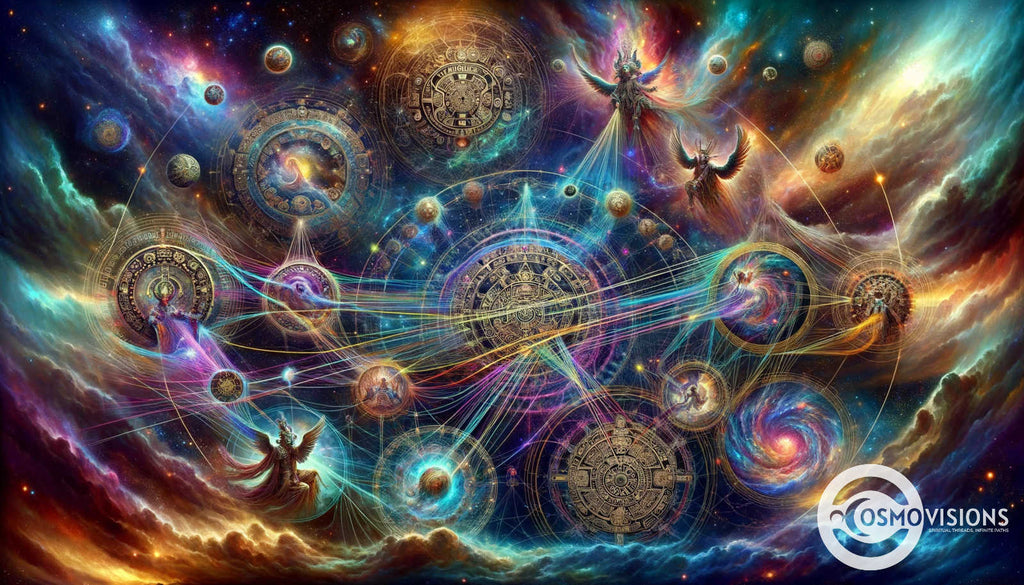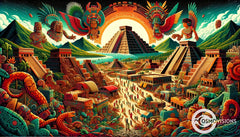Cosmic Loom: Weaving the Nepantla-Process in Aztec Metaphysics
Posted by Massimiliano Geraci

In the vast tapestry of human understanding, few threads are as unique and captivating as the metaphysical worldview of the ancient Aztecs. Deeply rooted in their culture and spiritual practices, this worldview presents the cosmos as an intricate weaving-in-progress, a dynamic fabric of reality crafted not by the hands of humans, but by the transformative forces of the universe itself. Central to this cosmic tapestry is a principle known as ‘nepantla’, a concept that holds the key to understanding the complex dynamics of the Aztec cosmos.
Understanding Nepantla: The Key to Aztec Metaphysics
So, what is nepantla? In Aztec metaphysics, nepantla signifies a transitional or middle space, a realm of transformation where opposing forces engage in an intricate dance of creation. This space is not static but is marked by continuous motion-change, reflecting the ever-evolving nature of the cosmos. Nepantla is the loom upon which the grand tapestry of existence is woven, the metaphysical stage where the drama of reality unfolds.
Understanding nepantla allows us to decode the dynamics of the Aztec cosmos, a cosmos that was not merely a physical realm but an intricate interplay of forces and energies. The Aztecs believed that the cosmos was in constant motion-change, a concept encapsulated by three key terms in their metaphysical lexicon - Olin, Malinalli, and Nepantla.
Olin, derived from the Nahuatl word for movement, signifies a cyclic oscillation, much like the rhythmic ebb and flow of the tides or the waxing and waning of the moon. It represents the cyclical aspect of the cosmos, the constant dance of creation and destruction, birth and death, growth and decay.
Malinalli, on the other hand, embodies a different type of motion-change. It refers to twisting or spiraling motion, akin to the whirl of a tornado or the coiling of a serpent. Malinalli captures the dynamic interplay of forces in the cosmos, the spiraling dance of energies that gives rise to the myriad forms of existence.
But it is Nepantla that is the most fundamental of these terms, for it encapsulates the transformative motion-change where the forces represented by Olin and Malinalli meet, interact, and generate new realities. Nepantla is the weaver’s hand that guides the threads of Olin and Malinalli, interlacing them into the grand cosmic tapestry.
From this perspective, the cosmos is not a static entity but a dynamic, ever-evolving fabric of interconnected forces and energies. Every entity, every force, every moment is a thread in this cosmic tapestry, interwoven through the transformative power of Nepantla.
The Fifth Sun-Earth Age: A Unique Nepantla Process
Among the Aztec’s intricate metaphysical tapestry, the Fifth Sun-Earth Age holds a distinct position. Unlike the previous four ages, it presents a unique weaving pattern, with the Fifth Sun functioning as the weft and the Tonalpohualli and Xiuhpohualli serving as the warp. This specific arrangement is not a mere cosmological detail but a vital element of the Aztec worldview, revealing profound insights into their understanding of the cosmos.
So, what makes the Fifth Sun-Earth Age unique? Essentially, the Fifth Sun's specific role, known as 4 Olin Tonatiuh in the Aztec cosmology, sets this age apart. As the weft of the cosmic tapestry, the Fifth Sun plays a crucial role in the Nepantla process. It is the driving force that interweaves the cosmic forces and energies, binding them together in a pattern that shapes the reality of the Fifth Sun-Earth Age.
This weaving pattern is not just a metaphorical concept but a tangible manifestation of the cosmic dynamics. The Fifth Sun’s trajectory across the sky, its daily rising and setting, mimics the undulating motion of the weft thread on the loom. As it traverses the cosmos, the Fifth Sun interlaces with the vertical warp threads of time — represented by the Tonalpohualli and Xiuhpohualli — integrating the vertical and horizontal dimensions of existence.
In this unique weaving pattern, every sunrise and sunset, every cycle of seasons, every ebb and flow of celestial energies, are interwoven threads in the cosmic fabric. The cosmos of the Fifth Sun-Earth Age is a grand tapestry continuously woven by the Nepantla process, with the Fifth Sun as the active weaver, binding together the cosmic forces in a harmonious pattern.
But the significance of this unique weaving pattern extends beyond the cosmic scale. It also resonates at the individual and societal levels. The Aztecs saw the cycles of human life — birth, growth, decay, and rebirth — as mirroring the cyclical patterns of the cosmos. The social order, with its complex interplay of roles and responsibilities, was seen as a reflection of the cosmic order, a social tapestry woven by the same principles that govern the cosmos.
In this light, the unique weaving pattern of the Fifth Sun-Earth Age is not just an abstract metaphysical concept but a lived reality. It is a principle that shapes the cosmos, society, and the individual, a guiding pattern that permeates every aspect of existence.
In essence, the Fifth Sun-Earth Age represents the culmination of the Nepantla process, a grand cosmic weaving where all threads of existence are intricately interwoven. It is a testament to the Aztec understanding of the cosmos as a dynamic, interconnected, and ever-evolving tapestry, a grand Nepantla-process that weaves the fabric of reality.

Nepantla and the First Four Sun-Earth Ages
Before we delve into the intricate intricacies of the Fifth Sun-Earth Age, it’s important to understand the context provided by the first four Sun-Earth Ages. While each of these ages had distinct characteristics and were governed by different cosmic forces, they all share a common thread—they were all part of the larger Nepantla-process that shapes the Aztec cosmos.
So, what are the first four Sun-Earth Ages? These ages, according to Aztec cosmology, were distinct periods in the history of the cosmos, each defined by a particular Sun and a set of unique cosmic conditions. These include the Age of the Jaguar Sun, the Age of the Wind Sun, the Age of the Rain Sun, and the Age of the Water Sun. Each age was believed to have ended in cataclysm, giving way to the birth of the next age.
But how do these ages relate to the nepantla-process? While each age was distinct, they were not separate or isolated from the overall cosmic weave. Rather, they were seen as different weavings within the larger tapestry of existence, each contributing to the grand cosmic narrative. The forces at play in each age—the gods that ruled, the creatures that populated the Earth, the cataclysms that ended each age—were all threads in this cosmic tapestry, interwoven through the Nepantla process.
In this perspective, the first four Sun-Earth Ages can be seen as a series of transformative phases in the cosmic Nepantla-process. Each age was a stage in the unfolding of the cosmos, a particular pattern in the cosmic tapestry. And while each age ended in destruction, this was not seen as an absolute end, but rather as part of the ongoing process of transformation—a necessary unravelling of the old to make way for the weaving of the new.
This understanding of the first four Sun-Earth Ages underscores the fluid and dynamic nature of the Aztec cosmos. It reflects a worldview that embraces change and transformation as inherent aspects of existence, where even the cataclysms that end each age are part of the natural ebb and flow of the cosmic weave.
In this light, the Aztec cosmos can be seen not as a static structure but as a grand loom, where the Nepantla process continuously weaves the threads of existence into ever-changing patterns. From the first Sun-Earth Age to the last, every moment, every force, every entity is part of this grand cosmic weaving, contributing to the vibrant tapestry that is the Aztec cosmos.
This perspective also offers a profound lesson: that in the grand weaving of the cosmos, no thread is insignificant, no pattern is permanent, and the only constant is the ceaseless dance of creation and transformation. It is a testament to the Aztec understanding of the cosmos as a grand Nepantla-process—a process that weaves the very fabric of reality.
The Cosmos as a Nepantla-Generated Woven House
In the rich tapestry of Aztec metaphysical thought, one analogy stands out for its depth and resonance—the cosmos as a ‘woven house’. This metaphor is not merely a poetic image but a core concept encapsulating the Aztec understanding of the cosmos.
So, what does it mean to view the cosmos as a ‘woven house’? Essentially, this metaphor captures the idea that the cosmos is a structured entity, much like a house, but instead of being built with bricks or stones, it is woven from the myriad forces and energies of existence. This ‘house’ is not a rigid, hierarchical structure, but a dynamic entity that is continually reshaped by the Nepantla process—the grand cosmic weaving that interlaces the threads of existence into a harmonious tapestry.
This metaphor of a woven house brings to light another significant aspect of Aztec culture—its architectural practices. Aztec architecture, much like its metaphysics, was not based on rigid, linear structures but on organic, flexible forms that mirrored the dynamic patterns of the cosmos. The construction of a house was seen as a microcosmic reflection of the construction of the cosmos, a process that involved the careful interweaving of different elements to create a harmonious whole.
In practice, this meant that Aztec houses were often built using techniques similar to weaving. Walls were constructed by interlacing reeds or branches, which were then coated with mud or clay to create a solid yet flexible structure—a woven wall. This technique was not only practical, providing insulation and resistance to seismic activity, but also symbolic, echoing the interlacing of forces in the cosmic weave.
The parallels between weaving and architectural practices extended to the social realm as well. Just as a house provides a structured space for family life, the woven cosmos provides a structured space for the social order. Each individual, like a thread in the cosmic tapestry, has a specific place and role in the social structure, contributing to the overall pattern of society.
In this perspective, the cosmos is not a distant, abstract entity, but a familiar, tangible reality—a woven house that we all inhabit. And just as a weaver crafts a house with care and skill, so we are all invited to participate in the weaving of the cosmos, to contribute our threads to the grand cosmic tapestry.
This metaphor of the cosmos as a woven house thus offers a powerful framework for understanding the Aztec worldview. It illuminates the intricate interconnections that bind the cosmos, society, and the individual, revealing a reality where everything is interwoven, where every thread matters, and where the grandeur of the cosmos is reflected in the humble structure of a woven house. This is the reality of the Nepantla process—a reality that is not just woven, but is continually being woven, in an ever-evolving dance of creation and transformation.

Embracing Reality as a Nepantla-Process
As we journey through the intricate patterns of the Aztec cosmos, a central theme emerges—the cosmos as a grand Nepantla-process. In this monumental weaving-in-progress, every moment, every entity, every force is a vital thread. This cosmic tapestry, crafted through the metaphysical ‘weaving’ of forces and energies, offers a unique window into the Aztec understanding of reality.
So, what does it mean to embrace reality as a Nepantla-process? Essentially, it involves seeing the cosmos not as a static entity, but as a dynamic, ever-evolving tapestry. It means recognizing that every entity, every force, every moment is interconnected, each contributing to the grand cosmic narrative. It means understanding that the cosmos is not something ‘out there’, separate and distant from us, but something we are part of, something we contribute to with every breath, every action, every thought.
This perspective also sheds light on the interconnectedness of all aspects of existence. In the grand cosmic weave, there are no isolated threads. The social order, the natural world, the spiritual realm—all are interwoven threads in the cosmic tapestry, shaped and guided by the Nepantla process. Embracing reality as a Nepantla-process thus fosters a sense of respect and responsibility towards other beings, towards the environment, and towards the spiritual forces that permeate the cosmos.
Moreover, embracing reality as a Nepantla-process provides a potent antidote to the illusion of permanence. It reminds us that change and transformation are not anomalies but the very fabric of existence. It teaches us that in the grand cosmic weave, no pattern is fixed, no thread is permanent, and the only constant is the ceaseless dance of creation and transformation.
This Aztec perspective, emphasizing interconnectedness, transformation, and the dynamic nature of reality, has much to offer in today’s world. As we grapple with global challenges and strive to create a sustainable future, the wisdom of the Aztec cosmos can serve as a guide, illuminating the intricate web of connections that bind us to each other and to the cosmos, and inspiring us to weave a world that reflects the harmony and balance of the grand cosmic tapestry.






















